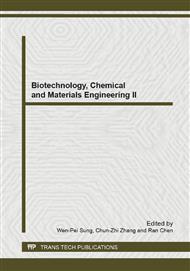p.638
p.645
p.654
p.666
p.675
p.684
p.693
p.701
p.712
Characterization of Synonymous Codon Usage Bias in the Riemerella Anatipestifer Major Facilitator Superfamily Mfs_1 Gene Encoded 492 Amino Acids Protein
Abstract:
Objective: The aim was to identify the codon usage bias between the newly identified Riemerella anatipestifer (RA) major facilitator superfamily mfs_1 gene (GenBank accession No.CP003388.1) and other reference bacteriums. Methods: A comparative analysis of the codon usage bias of the 18 bacteriums was performed by using the CodonW 1.4 program and CUSP (create a codon usage table) program of EMBOSS (The European Molecular Biology Open Software Suite). Results: The results showed obvious differences of the synonymous codon usage bias in the 18 bacteriums indicated by the Codon Adaptation Index (CAI), effective number of codons (ENc), and the value of G+C content at the 3rd codon position. The codon usage pattern of the major facilitator superfamily mfs_1 gene was phylogenetically conserved and similar to that of the major facilitator superfamily mfs_1 gene of the Elizabethkingia anophelis Ag1 Contig17, with a strong bias towards the codons with A and T at the 3rd codon position. A cluster analysis of codon usage pattern of the RA major facilitator superfamily mfs_1 gene with other reference bacteriums demonstrated that the codon usage bias of the major facilitator superfamily mfs_1 genes of the 18 bacteriums had a very close relation with their gene function. The ENc-plot revealed that the genetic heterogeneity in the RA major facilitator superfamily mfs_1 gene and the 18 reference bacteriums were constrained by G+C content, while gene length exerted relatively weaker influences. In addition, comparisons of the codon preferences in the major facilitator superfamily mfs_1 gene of RA with those of Escherichia coli, yeast and humans revealed that there were 36 codons showing distinct usage differences between the RA and E. coli, and 37 between the RA and humans, but only 28 between the RA and yeast. Therefore, the yeast system may be more suitable for the expression of the RA major facilitator superfamily mfs_1 gene. Conclusion: Together, these results may improve our understanding of the evolution, pathogenesis and functional studies of RA and possibly contribute significantly to the area of other bacteriums.
Info:
Periodical:
Pages:
675-683
Citation:
Online since:
January 2013
Authors:
Price:
Сopyright:
© 2013 Trans Tech Publications Ltd. All Rights Reserved
Share:
Citation:


